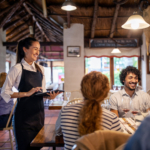Proven Upselling Strategies to Increase Average Ticket Size
Upselling is a concept we’re all somewhat familiar with. A customer places an order, and then staff suggests an additional item to add to their meal. Sounds simple enough. When executed well, upselling can be one of the biggest assets for your restaurant. Restaurants that focus on adding value to a guest’s order by suggesting a perfect combination or relevant additional item improve both the meal and the service for their guests. Properly upselling to your customers not only increases average ticket size—it can evoke a sense of trust, enhance the guest experience, and entice your customers to come back for more.
Upselling is an art and a science that drives success for both your restaurant and your customers. Below, we’ll dive into some proven restaurant upselling strategies that will have you analyzing every part of your restaurant’s customer journey.
1. Teach Your Staff How to Upsell
We’ve all been asked “Do you want fries with that?” or “Would you like to upgrade for $3 more?” This blanket approach to restaurant upselling can be very hit-or-miss. When an upsell isn’t presented thoughtfully, it can feel impersonal, pushy, or even desperate. By teaching your staff how to properly upsell, your customers will develop a level of trust with your staff and your business, feel encouraged to further explore the menu, and ultimately have an even better dining experience.
• Menu Training: This first one is imperative. The first thing your staff should do when hired is learn your menu inside and out. A deep understanding of the menu not only sets staff up to answer guests’ questions, but it also allows them to recommend upsells with enthusiasm and authenticity—two key ingredients in building trust. Equip staff with knowledge by conducting menu tests, allowing them to sample the menu, and teaching them about ingredients, preparation, and allergens.
• Be Sincere: Upselling isn’t just about making money — it’s about providing excellent service to your guests. You wouldn’t recommend an ice-cream sundae to a guest who ordered a salad and a diet soda. Approaching an upsell with a guest should feel like advice from a well-informed, passionate guide rather than a sales pitch. A personal touch and genuine recommendation can encourage the guest to trust you and maybe even try something they wouldn’t have considered without your assistance. Adjusting your wording from something basic like “Would you like to add fries?” to “I love our cheesy waffle fries with that sandwich! Want to give it a try?” turns your upsell moment into an impassioned, sincere suggestion.
• Incentivize Staff: Everybody loves a good challenge! The right incentives can make upselling feel more like a game or friendly competition. Your staff will also feel more encouraged and motivated to implement and master upselling strategies. Run a competition for who can sell the most combo meals or specials. Create a “staff bingo” game where the squares are items you want staff to upsell. Award the winners with prizes.
2. Identify Items with the Best Profit Margins
Upselling a higher price point item, like a higher-priced specialty pizza or larger order of wings, is a classic move and fine tactic. But to really maximize your revenue, identify menu items with high profit margins. Identifying which items deliver the most return allows you to make smarter, more informed upselling decisions.
Once you’ve established which items yield higher profit margins, you then can create specials, limited time offers (LTOs), and bundles. Take this a step further and intentionally place these high-margin items in your menu design.
• Specials: Build specials around high-margin items instead of discounting what may be low-margin dishes. This way, you can highlight items that keep your menu strong, even at a “special” price.
• LTOs: Running offers on high-margin dishes gives you the ability to offer promotions without hurting your bottom line. These could come in the form of buy-one-get-ones, limited time deals, or even seasonal specials.
• Bundles: Figuring out which items have the highest profit margins can help you create bundles that are not only profitable but also enticing to your guests. Pair high-margin items with popular sides or low-cost drinks to create value-packed bundles that feel like a fantastic deal to the guest but still maintain high profit margins.
3. Menu Design
Your physical menu is more than just a list. A great menu is a silent salesperson working behind the scenes. Strategic menu design can make a big impact on what guests order and how much they spend. Place high-margin items in the most visible spots, like the top right of digital menu boards or at eye level on printed menus. This helps draw attention to the choices you want to sell more of. Simple callouts like “Guest Favorite” or “Best Value” can nudge customers toward bundles, upgrades, or premium items without needing a word from your staff. Include tempting add-ons or modifiers right next to core items. Examples of this might be “Add guac,” “Upgrade to a combo,” or “Try with our house sauce” which can encourage guests to build a bigger, better meal. When you design your menu to do some of the talking, it takes pressure off your team and consistently boosts ticket size.
4. Utilize Tech
If your point-of-sale system isn’t your best friend, it should be. With the correct technology in place, a whole new world of data and marketing strategies will be at your fingertips. This applies to your web tech, as well, through your CRM system or website, and even through third-party delivery apps.
• POS: The correct POS can make upselling a breeze. At the very least, your POS should have the ability to prompt restaurant staff to suggest specific upsells based on the customer’s order. For example, if a customer is ordering a salad, your POS should prompt staff to suggest modifiers like chicken, avocado, or extra bacon. The way your POS suggests these items (whether through pop-up suggestions, modifiers, or the like) should feel natural, relevant, and add genuine value to the customer experience.
• Online Ordering: Set up your online ordering system to upsell itself. When a customer is building their order, they should be shown suggestions for additional toppings, modifiers, and even add-ons.
When a customer is building their order, utilize prompts to suggest additional toppings, modifiers, or add-ons. This can look like adding chicken to a salad, turning your item into a combo, or adding a relevant side dish or drink. A strategically placed, relevant add-on or modifier not only leads to larger carts but puts the decision in the guest’s hands without added pressure.
Not only can you do this on your own website and online ordering platform, but you can integrate promotions to your UberEats, DoorDash, or other third-party ordering platform page. Typically, on these platforms, you can offer incentives for repeat customers, bundles, and free or discounted items. (Keep an eye on the fees associated with marketing on these platforms, though, before deciding if it’s the right move for your business!)
Why Choosing the Right POS is Important
HungerRush makes upselling not only seamless and beneficial for your guests, but simple for you and your staff.
At HungerRush, our goal is to bring our restaurant expertise into our technology. Imagine the impact of every customer adding an additional side or dessert to their order. Or imagine guests drooling over your specials and highest margin entrees first every time. This is the value of choosing the right technology for your restaurant business. The experts who develop our user interfaces—from the point-of-sale order entry interface for your staff to the online ordering platform for your guests—design these with simplicity and automation in mind. Upselling instructions automatically appear so in-store staff never forget to properly and efficiently upsell on every order. Suggestive selling for add-ons and specials are built into the online ordering system. When using HungerRush, your guests come first every time. This leads to a satisfying experience for them, and a profitable and easy one for you.




